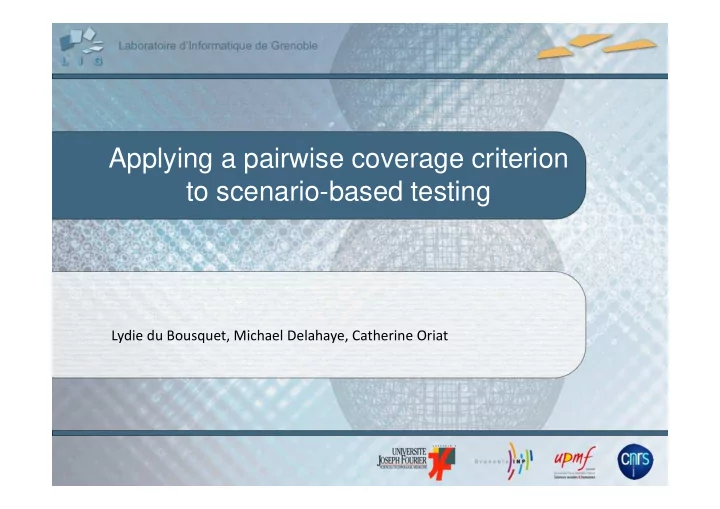

Applying a pairwise coverage criterion to scenario-based testing Lydie du Bousquet, Michael Delahaye, Catherine Oriat
Example: Bounded-Stack public class BoundedStack { private int[] elems ; private int numberOfElements ; private int max ; public BoundedStack () {…} public void push(int k) {…} public void pop() {…} public int top() {…} public boolean isEmpty() {…} }
Vocabulary � A test suite ‣ Set of test cases ‣ Size: number of test cases � A test case ‣ Sequence of method calls ‣ Sequence of method calls ‣ Size: number method calls � Example: ‣ T1: BoundedStack(); pop(); top(); ‣ T2: BoundedStack(); IsEmpty(); push(6);
Scenario-based testing � To test the class, ‣ Init the object ‣ Apply different instantiated calls � Scenario: C; M 3..3 ‣ C = { “int res; stack s = new stack(); int i = -1;” } ‣ M = { “s.push(i++);”; “s.push(-1);”; “s.pop();”; “s.top();” } � Complete unfolding => Test suite of 4 3 test cases
Executable test cases Oracle is not the subject of the article. It can be implemented with assertions embedded in the code
Complete unfolding: combinatorial explosion � [Arcuri] Size of the test cases is important to expose failure � C; M 3..3 -> C; M 10..10 (for instance) ‣ Combinatorial explosion! ‣ So many test cases might not be relevant (execution cost) � Need to select a subset of test cases � Different strategies for selection ‣ Randomly: But how many ? ‣ W.r.t some coverage criteria: why not pairwise ? ๏ Simple to apply ๏ A priori relevant in the sense that the order of calls has an importance push(1); pop(); different from pop(); push(1);
Pairwise coverage applied to method calls C; M; M; M; c1 m1 m1 m1 c2 c2 m2 m2 m2 m2 m2 m2 m3 m3 m3 m4 m4 m4 m5 m5 m5
Pairwise coverage applied to method calls C; M; M; M; c1 m1 m1 m1 c2 c2 m2 m2 m2 m2 m2 m2 m3 m3 m3 m4 m4 m4 m5 m5 m5
Is this coverage relevant? � Experimentation � Hypothesis: Random better than pairwise � Subjects: 15 classes under tests ‣ Containers and other types of classes with internal classes Containers and other types of classes with internal classes � Test suites generated from scenarios: C; M i..i ‣ 252 test configurations = { SUT, C, M, i } ‣ Pairwise selection with ACT => 100 test suites by configurations ‣ Random selection => 100 test suites by configurations, same size
Test suite size
Mutation analysis � Mutant = Program under test + a single fault ‣ Fault introduced w.r.t. mutation operator (e.g. + is transformed into -) ‣ Mutant killed if Mutant and Original programs give different results ‣ Mutation score: number of mutant killed by a test suite � Trivial mutants are removed ‣ Mutants killed by a test case composed of a single method call ‣ Not relevant w.r.t. Pairwise hypothesis � 1720 Non trivial mutants for the 15 classes under test � Experimentation: comparing mutation score
Mutation score in average
Experiental results � Contingency table ‣ Pairwise test suites: PT ‣ Random test suites: RT � Wilcoxon signed-rank test ‣ p-value of 8:22810 ‣ Hypothesis can be rejected with more than 95% confidence ‣ (even with more than 99%)
Threats of validity � Program under test (number and type) � Choice of data � Type of faults (mutation)
Conclusion & perspectives � Pairwise coverage better than random selection � Longer is better (see Arcuri) � Size of pairwise test suite relevant � New experiments with more complex scenarios
Recommend
More recommend